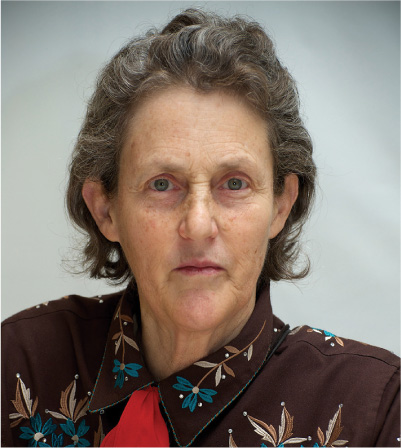15.7 Disorders of Childhood and Adolescence
All of the disorders described above can have their onset during childhood, adolescence, or adulthood. Some often begin early in life (lots of adolescents develop anxiety disorders or depression), and in fact half of all disorders begin by age 14, and three-
Autism Spectrum Disorder
Marco is a 4-
Autism spectrum disorder (ASD) is a condition beginning in early childhood in which a person shows persistent communication deficits as well as restricted and repetitive patterns of behaviors, interests or activities. In DSM–5, ASD now subsumes multiple disorders that were considered separate in DSM–IV: autistic disorder, Asperger’s disorder, childhood disintegrative disorder, and pervasive developmental disorder not otherwise specified (i.e., these disorders are no longer recognized in the DSM).
The true rate of ASD is difficult to pinpoint, especially given the recent change in diagnostic definition. Estimates from the 1960s indicated that autism was a rare diagnosis, occurring in 4 per 10,000 children. Estimates have been creeping up over time and now stand at approximately 10 to 20 per 10,000 children. If one considers the full range of disorders that now fall under the ASD umbrella in the DSM–5, the rate is 60 per 10,000 children (Newschaffer et al., 2007). It is unclear whether this increased rate is due to increased awareness and recognition of ASD, better screening and diagnostic tools, or to some other factor. Boys have higher rates of ASD than girls by a ratio of about 4:1.

What is the relationship between ASD and empathy?
Early theories of autism described it as “childhood schizophrenia,” but it is now understood to be separate from schizophrenia, which is rarely diagnosed in children, emerging mainly in adolescence or young adulthood (Kessler & Wang, 2008). ASD is currently viewed as a heterogeneous set of traits that cluster together in some families (heritability estimates for ASD are as high as 90%), leaving some children with just a few mild ASD traits and others with a more severe form of the disorder (Geschwind, 2009). Interestingly, some people with ASD have unique strengths. For instance, some people with ASD have remarkable abilities to perceive or remember details, or to master symbol systems such as mathematics or music (Happé & Vital, 2009).
One current model suggested that ASD can be understood as an impaired capacity for empathizing, knowing the mental states of others, combined with a superior ability for systematizing, understanding the rules that organize the structure and function of objects (Baron-
615
Although many people with ASD experience impairments throughout their lives that prevent them from having relationships and holding down a job, many go on to very successful careers. The renowned behavioral scientist and author Temple Grandin (2006) has written of her personal experience with autism. She was diagnosed with autism at age 3, started learning to talk late, and then suffered teasing for odd habits and “nerdy” behavior. Fortunately, she developed ways to cope and found a niche through her special talent—
HOT SCIENCE: Optimal Outcome in Autism Spectrum Disorder
What comes to mind when you think of the word autism? What kind of person do you imagine? If an adult, what do you imagine that they do for a living? Can they hold a job? Can they care for themselves? Autism spectrum disorder (ASD) is considered by many to be a lifelong condition in which those affected will forever experience significant difficulties and disability in their interpersonal, education, and occupational functioning. Several recent studies are helping to change this outlook.

Deborah Fein and colleagues (2013) recently described a sample of people who were diagnosed with autism as children, but who no longer met criteria for ASD. How could this be? For years, researchers have noticed that some portion of children diagnosed with autism later fail to meet diagnostic criteria. One recent review suggested that 3 to 25% of children ultimately lose their ASD diagnosis over time (Helt et al., 2008). There are several potential explanations for this. The most obvious is that some portion of children diagnosed with ASD are misdiagnosed and don’t really have this disorder. Perhaps they are overly shy, or quiet, or develop speech later than other children, and this is misinterpreted as ASD. Another possibility is that children who lose their ASD diagnosis had a milder form of the disorder and/or were identified and treated earlier. There is some support for this idea, as predictors of recovery from ASD include high IQ, stronger language abilities, and earlier age of identification and treatment (Helt et al., 2008).
The possibility of effectively treating ASD initially was raised in an important study by Ivar Lovaas in 1987. Lovaas assigned 19 children with autism to an intensive behavioral intervention in which they received over 40 hours per week of one-
Extending this earlier work, Geraldine Dawson and colleagues (2010) are testing a program called the Early Start Denver Model (ESDM), an intensive behavioral intervention (20 hours per week for 2 years) similarly designed to improve outcomes among those with ASD. Using randomized, controlled trials, Dawson and colleagues found that toddlers with ASD who received ESDM, compared to those receiving standard community treatment, showed significant improvements in IQ (a 17-
How effective are intensive behavioral interventions like those described here? Fein and colleagues’ (2013) data suggest that some people diagnosed with ASD can achieve optimal outcomes, meaning they do not differ from typically developing people in IQ, language, communication, or socialization—
616
Attention-Deficit/Hyperactivity Disorder
What are the criteria for an ADHD diagnosis?
Chances are you have had the experience of being distracted during a lecture or while reading one of your other textbooks. We all have trouble focusing from time to time. Far beyond normal distraction, attention deficit/hyperactivity disorder (ADHD), is a persistent pattern of severe problems with inattention and/or hyperactivity or impulsiveness that cause significant impairments in functioning. This is quite different than occasional mind wandering or bursts of activity. Meeting criteria for ADHD requires having multiple symptoms of inattention (e.g., persistent problems with sustained attention, organization, memory, following instructions), hyperactivity–impulsiveness (e.g., persistent difficulties with remaining still, waiting for a turn, interrupting others), or both. Most children experience some of these behaviors at some point, but to meet criteria for ADHD, a child has to have many of these behaviors for at least 6 months in at least two settings (e.g., home and school) to the point where they impair the child’s ability to perform at school or get along at home.
Approximately 10% of boys and 4% of girls meet criteria for ADHD (Polanczyk et al., 2007). The DSM–5 requires that symptoms of ADHD be present before the age of 12 in order to meet criteria for this disorder. As you can imagine, children and adolescents with ADHD often struggle in the classroom. One recent study of 500 people with ADHD found that about half had a C average or lower, and about one-
Because ADHD, like most disorders, is defined by the presence of a wide range of symptoms, it is unlikely that it emerges from one single cause or dysfunction. The exact cause of ADHD is not known, but there are some promising leads. Genetic studies suggest that there is a strong biological influence and estimate that the heritability of ADHD is 76% (Faraone et al., 2005). Brain imaging studies suggest that those with ADHD have smaller brain volumes (Castellanos et al., 2002) as well as structural and functional abnormalities in frontosubcortical networks associated with attention and behavioral inhibition (Makris et al., 2009). The good news is that current drug treatments for ADHD are effective and appear to decrease the risk of later psychological and academic problems (Biederman et al., 2009).
Conduct Disorder
Michael is an 8-
617
Why is it difficult to pin down the causes of conduct disorder?

Conduct disorder is a condition in which a child or adolescent engages in a persistent pattern of deviant behavior involving aggression to people or animals, destruction of property, deceitfulness or theft, or serious rule violations. Approximately 9% of people in the United States report a lifetime history of conduct disorder (12% of boys and 7% of girls; Nock et al., 2006). This number may seem a bit high, but approximately 40% of those with conduct disorder have, on average, only 3 symptoms that cluster into one of three areas: rule breaking, theft/deceit, or aggression toward others. The other 60% have more symptoms, on average 6 to 8 of the 15 defined symptoms, with problems in many more areas and a much higher risk of having other mental disorders later in life (Nock et al., 2006).
Meeting criteria for conduct disorder requires having any 3 of the 15 symptoms of conduct disorder. This means there are approximately 32,000 different combinations of symptoms that could lead to a diagnosis, which makes those with conduct disorder a pretty diverse group. This diversity makes it difficult to pin down the causes of conduct disorder. One thing that seems clear is that a wide range of genetic, biological, and environmental factors interact to produce this disorder. Indeed, risk factors for conduct disorder include maternal smoking during pregnancy, exposure to abuse and family violence during childhood, affiliation with deviant peer groups, and the presence of deficits in executive functioning (e.g., decision making, impulsiveness; Boden et al., 2010; Burke et al., 2002). Researchers currently are attempting to better understand the pathways through which inherited genetic factors interact with environmental stressors (e.g., childhood adversities) to create characteristics in brain structure and function (e.g., reduced activity in brain regions associated with planning and decision making) that interact with environmental factors (e.g., affiliation with deviant peers) to lead to the behaviors that are characteristic of conduct disorder. Not surprisingly, conduct disorder tends to be comorbid with other disorders characterized by problems with decision making and impulsiveness, such as ADHD, substance use disorders, and antisocial personality disorder, which is described in more detail in the next section.
 Some mental disorders always begin during childhood or adolescence, and in some cases (ASD, ADHD) persist into adulthood.
Some mental disorders always begin during childhood or adolescence, and in some cases (ASD, ADHD) persist into adulthood. ASD emerges in early childhood and is a condition in which a person has persistent communication deficits as well as restricted and repetitive patterns of behavior, interests, or activities.
ASD emerges in early childhood and is a condition in which a person has persistent communication deficits as well as restricted and repetitive patterns of behavior, interests, or activities. ADHD begins by age 12 and involves a persistent pattern of severe problems with inattention and/or hyperactivity or impulsiveness that cause significant impairments in functioning.
ADHD begins by age 12 and involves a persistent pattern of severe problems with inattention and/or hyperactivity or impulsiveness that cause significant impairments in functioning. Conduct disorder begins in childhood or adolescence and involves a persistent pattern of deviant behavior involving aggression to people or animals, destruction of property, deceitfulness or theft, or serious rule violations.
Conduct disorder begins in childhood or adolescence and involves a persistent pattern of deviant behavior involving aggression to people or animals, destruction of property, deceitfulness or theft, or serious rule violations.
618